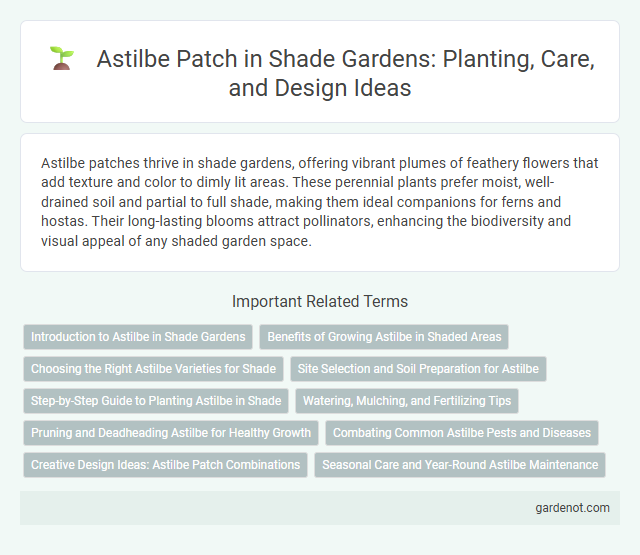Astilbe patches thrive in shade gardens, offering vibrant plumes of feathery flowers that add texture and color to dimly lit areas. These perennial plants prefer moist, well-drained soil and partial to full shade, making them ideal companions for ferns and hostas. Their long-lasting blooms attract pollinators, enhancing the biodiversity and visual appeal of any shaded garden space.
Introduction to Astilbe in Shade Gardens
Astilbe, a popular perennial for shade gardens, thrives in moist, well-drained soil and provides vibrant, feathery plumes of pink, white, or red flowers. This shade-loving plant adds texture and color contrast beneath trees or along shaded borders, enhancing garden diversity. Its low maintenance and deer resistance make Astilbe ideal for creating lush, colorful patches in shady landscapes.
Benefits of Growing Astilbe in Shaded Areas
Astilbe thrives in shaded garden areas, offering vibrant plumes of flowers that enhance visual interest during the summer months. Its tolerance for low light and moisture retention helps prevent soil erosion while supporting local pollinators like bees and butterflies. The plant's dense foliage adds texture and covers bare spots, improving the overall health and aesthetics of shade gardens.
Choosing the Right Astilbe Varieties for Shade
Selecting the right Astilbe varieties for shade involves prioritizing cultivars known for thriving in low-light conditions, such as Astilbe 'Fanal', 'Brautschleier', and 'Rheinland'. These varieties are prized for their vibrant plumes, disease resistance, and ability to maintain lush foliage in shady garden patches. Ensuring well-drained, consistently moist soil enhances growth, making these Astilbe types ideal for creating vivid, textured underplantings in shaded landscapes.
Site Selection and Soil Preparation for Astilbe
Astilbe thrives in partial to full shade, requiring a site with morning sun and protection from harsh afternoon rays to prevent leaf scorch. The soil must be rich in organic matter, consistently moist, and well-draining to support optimal growth and vibrant blooms. Incorporating compost or aged manure enhances soil fertility and moisture retention, creating ideal conditions for a healthy Astilbe patch.
Step-by-Step Guide to Planting Astilbe in Shade
Plant Astilbe in a shade garden by selecting a location with dappled or partial shade and consistently moist, well-drained soil rich in organic matter. Start by preparing the soil with compost or peat moss to improve moisture retention, then dig holes twice as wide as the root balls and space plants about 12 to 18 inches apart to encourage airflow and healthy growth. After planting, water thoroughly and mulch with bark or leaf mulch to maintain soil moisture and regulate temperature, ensuring Astilbe thrives in its shaded environment.
Watering, Mulching, and Fertilizing Tips
Astilbe patches thrive in consistently moist soil, requiring regular watering to prevent dryness, especially during hot weather. Applying a 2-3 inch layer of organic mulch helps retain soil moisture, regulate temperature, and suppress weeds around the plants. Fertilizing with a balanced, slow-release fertilizer in early spring promotes vigorous growth and abundant blooms in shaded garden areas.
Pruning and Deadheading Astilbe for Healthy Growth
Pruning and deadheading Astilbe encourage vigorous growth and extended blooming in shade gardens by removing spent flowers and cutting back old foliage. Trim flower stalks to the base soon after blooming to redirect energy into healthy new shoots, enhancing the plant's overall vitality. Regular maintenance also helps prevent disease and promotes a tidier appearance, ensuring a lush and vibrant Astilbe patch throughout the growing season.
Combating Common Astilbe Pests and Diseases
Astilbe patches are often affected by pests such as aphids, slugs, and spider mites, which can cause leaf distortion and discoloration. Effective management includes regular inspection, using insecticidal soap, and maintaining good air circulation to prevent fungal diseases like powdery mildew and root rot. Incorporating organic mulch and ensuring well-drained soil conditions reduces pest habitat and enhances Astilbe health.
Creative Design Ideas: Astilbe Patch Combinations
Astilbe patches thrive in shaded garden areas, pairing beautifully with hostas and ferns to create layered textures and vibrant contrasts. Combining different Astilbe varieties with varying bloom colors and heights intensifies visual interest while ensuring continuous flowering throughout the growing season. Incorporate companion plants such as heucheras and Japanese forest grass to enhance the patch's ornamental appeal and support soil moisture retention.
Seasonal Care and Year-Round Astilbe Maintenance
Astilbe patches thrive with consistent moisture and partial to full shade, requiring well-drained, humus-rich soil for optimal growth. Seasonal care involves mulching in early spring to retain moisture and protect roots, while removing spent flowers promotes new blooms and vibrant foliage throughout summer. Year-round maintenance includes dividing clumps every 3-4 years in early spring or fall to prevent overcrowding and ensure vigorous plant health.
Astilbe patch Infographic

 gardenot.com
gardenot.com